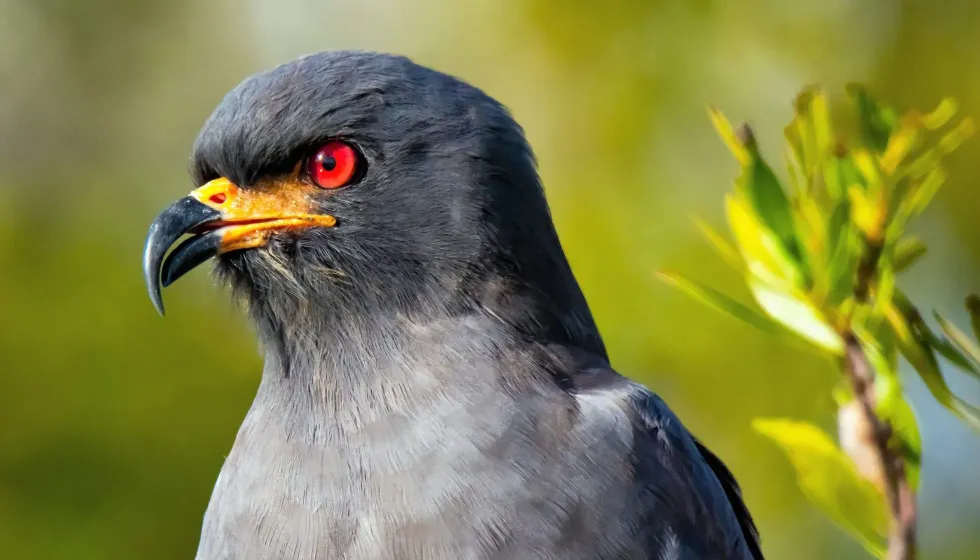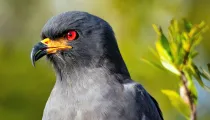The Everglade snail kite is a fascinating creature to read about. They have been named so because they hail from the Everglades region in Florida, however, they are not found only in that region of the American landmass.
The other geographic distribution of this apple snail predator ranges around Lake Kissimmee, located in Florida. These places provide an ideal habitat for these kites.
The habitat is mostly situated around water bodies and wetlands. Such bodies of water are filled with young vegetation.
Such vegetation may include water hyacinth and water fern, among others. The apple snail feeds on this vegetation like the water hyacinth. Since these snails are the primary source of food for the Everglade snail kites, these regions naturally pose as the perfect Everglade snail kite habitat.
Interestingly, these kites can go as far as 6 in (15.2 cm) deep into the water to catch an apple snail. The apple snail itself is about 2-3 in (5-7.6 cm) in length.
Other animals that the kites source as food from the water are crayfish and also small turtles on some rare occasions. Keep on reading to know and learn more about their food habits and other interesting facts!
For more similar content, check out interesting facts about the red kite and Mississippi kite
Everglade Snail Kite Interesting Facts
What type of animal is an Everglade snail kite?
The Everglade snail kite (Rostrhamus sociabilis) is a type of bird.
What class of animal does an Everglade snail kite belong to?
The Everglade snail kite belongs to the class Aves, like all other kites, including the swallow-tailed kite.
How many Everglade snail kites are there in the world?
The overall population of the Everglade snail kite remains unknown. However, some have reported their population in the United States to be within the range of 1000.
There have been speculations over the Florida population of this species. Some studies have shown that the Florida population of these birds rose to 3000 in 1999. Their population in other parts of the world has not yet been recorded.
Where does an Everglade snail kite live?
Everglade snail kites can be found all across America. It means that the geographic range of these snail kites spans North, Central, and South America.
In North America, the United States (U.S.), Mexico, and Cuba are home to these birds. Within the United States, this species is endemic to Florida in places like Lake Kissimmee. In fact, their name is derived from a wetland named the Everglades in South Florida.
What is an Everglade snail kite's habitat?
The Everglade snail kites have a riparian habitat. This means that they stay near water bodies. The habitat of these snail kites is particularly in the vicinity of freshwater bodies like rivers, streams, lakes, marshes, and ponds.
This species of snail kites reside near water bodies that are spread across a large area. This is in order to gain access to an ample amount of apple snails (Pomacea paludosa) which is their staple diet. Such bodies of water are usually filled with newly growing vegetation.
As a result, apple snails reside there. Near these freshwater bodies, there should be an ample amount of trees and plantations. The habitat of these snail kites should also be filled with shrubs.
Who does the Everglade snail kite live with?
This species of snail kites are social beings. They are known to form groups while roosting. Such groups may comprise 15-20 of these snail kites. The Everglade snail kites prefer to roost in bushes amidst the water. These snail kites can also be seen flying together in groups or flocks. They also preen together.
How long does an Everglade snail kite live?
On average, the Everglade snail kites have a lifespan of about 14 years.
How do they reproduce?
The breeding population of the Everglade snail kites mates between the months of February and June. However, on rare occasions, the Everglade snail kite breed outside their breeding season as well. Males display courtship acts in order to woo females during the breeding season.
Most of these acts are performed in the air. Males flap their wings at a slowed pace while going up and down in the air.
Following this, a pair forms between males and females. Thereafter, females go scavenging for food and nesting materials for their partner. The nesting season usually takes place from February till July.
However, nesting season can also be observed outside of these months. Common nests are used by birds in a colony. The female then lays the eggs in the nest.
Said eggs could be of varying colors from one clutch to another, ranging from brown or white to even spotted ones. The incubation period goes on for about 27-28 days.
Both the male and the female incubate these eggs. After the young ones are born, both the parents take turns to look after them. It takes a couple of months for the young ones to become independent.
What is their conservation status?
As per the International Union for Conservation of Nature (IUCN) Red List, the Everglade snail kites fall under the category of Least Concern. This indicates that there is no forthcoming or persisting threat to their population as of yet. However, under the U.S. Federal List, the Everglade snail kites are listed as Endangered.
Everglade Snail Kite Fun Facts
What does the Everglade snail kite look like?
These are birds of medium size. Males are generally a tad bit larger than females. Male Everglades have a slate gray plumage with a bit of orange color on their wings. Additionally, they have orange legs.
The female has a brown and white striped plumage, coupled with yellow-colored legs. They both have dark tails and red eyes. Their bodies are slender or sleek, while they have a curved bill.
How cute are they?
Everglade snail kites are not cute birds. On the contrary, this bird looks ferocious. They can also be demarcated as birds of prey.
How do they communicate?
Not much is known about the communication techniques of the Everglade snail kite. The only thing known so far about the communication of these birds is the channels through which they do so.
The Everglade snail kite has been observed to communicate through the use of sound, sight, touch. Additionally, they have the ability to perceive their surroundings with the assistance of chemical signals.
How big is an Everglade snail kite?
These birds from Florida can measure around 14-16 in (35.5-40.6 cm) in length. They are more than four times the size of a Fischer's lovebird and double the size of peach-faced lovebirds.
How fast can an Everglade snail kite fly?
The speed at which an Everglade snail kite flies is not known. Almost exclusively feeding on apple snails results in reducing their need to have a fast-paced flight. Their flight is said to lack grace and has slow flapping of the wings.
How much does an Everglade snail kite weigh?
The average population of these birds weighs about 12-20 oz (340-567 g).
What are the male and female names of the species?
The male bird is called a cock. Meanwhile, the female bird is termed a hen.
What would you call a baby Everglade snail kite?
A baby bird is called a chick. However, in the initial stages of their life, they are called hatchlings. Subsequently, the young ones have been termed fledglings once they learn to fly and leave their nests.
What do they eat?
Apple snails make up the primary source of nutrition for these animals. One of the main reasons that these Everglade snail kite's habitat or geographic range comprises freshwater (marshes, wetlands, lakes) is because of the availability of apple snails in these places.
Such a range comprising of marshes, lakes, wetlands, ponds, and other freshwater bodies, also harbors fish. As a result, crayfish can also act as the kite's food.
They also feed on small turtles at times. In order to catch their prey, the Everglade snail kites pull the prey from the aquatic habitat.
The kite's ability to descent quickly after swooping at an elevation of 20 ft (6 m) above this aquatic region plays a major role in catching the prey. Moreover, the Everglade snail kites feed on the apple snails by taking them out of their shells with their curved bill feature.
Hence, their feeding pattern is largely dependent on their native or natural surroundings. The snail-kite habitat is intertwined, making the apple snails perfect aquatic creatures for the snail kites.
Are they dangerous?
No, these kites have not proved themselves to be dangerous. Although they are known to be birds of prey, they have a very limited diet. This native bird of Florida has a curved and sharp bill. But they do no cause harm to other animals or to humans with their bill.
Would they make a good pet?
Ideally, birds of prey do not make good pets. There has been no record that shows the Everglade snail kite to be a pet, let alone a good one.
Did you know...
There are really no known natural predators that eat these kites as they are themselves raptors or birds of prey!
Why is the Everglade snail kite endangered?
The conservation status of these birds is listed as Endangered species by the U.S. Federal List because their numbers are believed to be on a decline owing to habitat loss. The changing water levels of their natural surroundings (like marshes, wetlands, and ponds) is one of the topmost factors that contribute towards the Endangered status of this species.
Where are the snail kites in Florida?
This endangered animal can be found in both Central and South Florida. They are native to lake habitats and shores in Central America, whereas South Florida hosts these birds in Everglades. They are usually found in large lakes such as Lake Okeechobee.
Apart from Lake Okeechobee, they also build nests near Lake Tohopekaliga and Lake Kissimmee. However, they can and do migrate to other parts of Florida sometimes.
Migration generally takes place from a larger to a smaller lake throughout Central and South Florida. The months between February and August are when they build nests in Florida. Their home range in Florida is dependant on the availability of snails in the different lake zones they inhabit.
Here at Kidadl, we have carefully created lots of interesting family-friendly animal facts for everyone to discover! For more relatable content, check out these African pygmy goose facts and red finch facts pages.
You can even occupy yourself at home by coloring in one of our free printable Everglade snail kite coloring pages.









